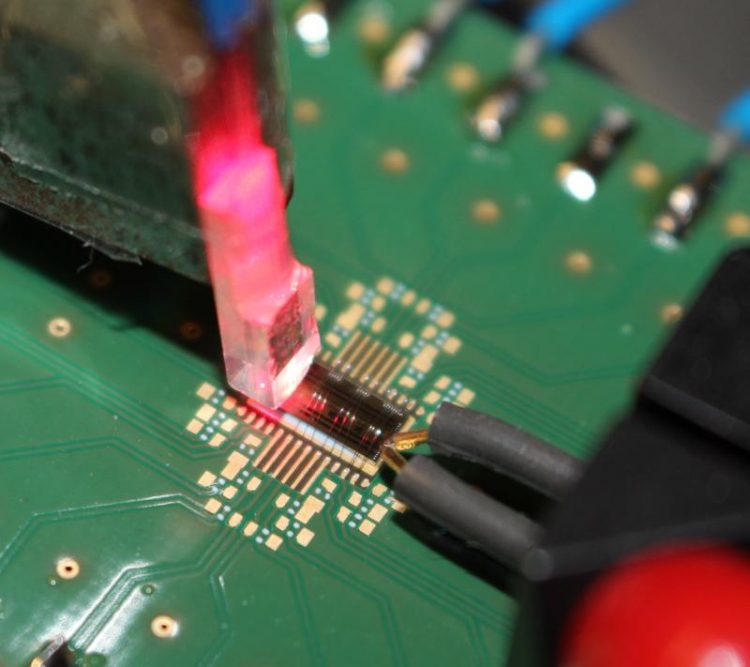Integrated time magnifier for the detection and measurement of very short signals

Electronic-optical silicon chip with coupling of optical (left) and high-frequency electrical signals (right) on a conventional electrical circuit board. Arijit Misra/TU Braunschweig, free for publication
The steadily increasing usage of streaming services, online games and social media results in ever-increasing data rates and thus ever shorter signals in the global communication networks. For very short signals, however, electronic systems are too slow to detect or measure them.
To see extremely small objects, microscopes or lenses can be used to magnify the image of the object so that the naked eye is sufficient to recognize it. The same idea can also be used for extremely short signals; i.e. a time lens magnifies the signal in time so that it can be detected by slow electronics.
Previously shown time lenses are based on the fact, that a very short signal consists of many individual frequencies. The shorter the signal, the more frequencies occur. In a so-called dispersive waveguide, e.g. an optical fiber, these signal frequencies propagate at different speeds.
At the output of the fiber, first the high, then the middle and at last the low frequencies will occur. The input signal is thus stretched in time and can eventually be measured by slow electronics. For most applications of this technique, it would be very advantageous to have an integrated version of such time lenses on a chip.
However, dispersive waveguides are usually relatively long, they are hard or even impossible to integrate and so-called higher-order dispersions lead to distortions of the signal.
The THz-Photonics Group of TU Braunschweig, led by Thomas Schneider, together with Linjie Zhou from the state key laboratory of advanced optical communications systems and networks at the Shanghai Jiao Tong University has now developed a new method for the time magnification of optical or even electrical signals, which can be integrated on a single chip.
For this purpose, the signal is first coupled into a ring resonator (simply a ring with coupling and decoupling). If the round-trip time in the ring is higher than the duration of the signal, just one single copy of the signal will be extracted from the ring at each round trip. The time between two copies of the signal corresponds to the round-trip time and the number of copies depends on the signal energy in the ring.
In a second step, two coupled modulators are used to scan the individual copies. A very short pulse is multiplied with the copies of the signal. Thus, the amplitude value of the signal is measured exactly at the timely pulse position. If the repetition rate of the signal after the ring is slightly different from the repetition rate of the sampling pulses, each individual copy of the signal is measured at a different position. The envelope over the individual samples is the temporally magnified input signal, which can now be measured with slow electronics.
The ring resonator was integrated on a silicon nitrite chip. The two coupled modulators used in the proof of concept setup are still standard Telekom devices. However, both modulators can be integrated with the ring resonator and additional electronics on a single complementary metal oxide semiconductor (CMOS) chip. The same technology as used in the production of computer chips.
The method enables integrated, cost-effective analog to digital converters and measuring systems with extremely small dimensions for the characterization of single, irregular events with a fast change and very large bandwidths up to the THz range.
Prof. Dr. Thomas Schneider
Technische Universität Braunschweig
Institute of High Frequency Technology
THz-Photonics group
Schleinitzstraße 22
38106 Braunschweig
Tel.: +49 531 391-2003
E-Mail: thomas.schneider@ihf.tu-bs.de
A.Misra, S. Preussler, L. Zhou and T. Schneider “Nonlinearity- and dispersion- less integrated optical time magnifier based on a high-Q SiN microring resonator” Scient. Rep. 10.1038/s41598-019-50691-2 (SREP-19-24563-T). In Scientific Reports https://rdcu.be/bSSAG
Media Contact
All latest news from the category: Power and Electrical Engineering
This topic covers issues related to energy generation, conversion, transportation and consumption and how the industry is addressing the challenge of energy efficiency in general.
innovations-report provides in-depth and informative reports and articles on subjects ranging from wind energy, fuel cell technology, solar energy, geothermal energy, petroleum, gas, nuclear engineering, alternative energy and energy efficiency to fusion, hydrogen and superconductor technologies.
Newest articles

NASA: Mystery of life’s handedness deepens
The mystery of why life uses molecules with specific orientations has deepened with a NASA-funded discovery that RNA — a key molecule thought to have potentially held the instructions for…

What are the effects of historic lithium mining on water quality?
Study reveals low levels of common contaminants but high levels of other elements in waters associated with an abandoned lithium mine. Lithium ore and mining waste from a historic lithium…

Quantum-inspired design boosts efficiency of heat-to-electricity conversion
Rice engineers take unconventional route to improving thermophotovoltaic systems. Researchers at Rice University have found a new way to improve a key element of thermophotovoltaic (TPV) systems, which convert heat…



